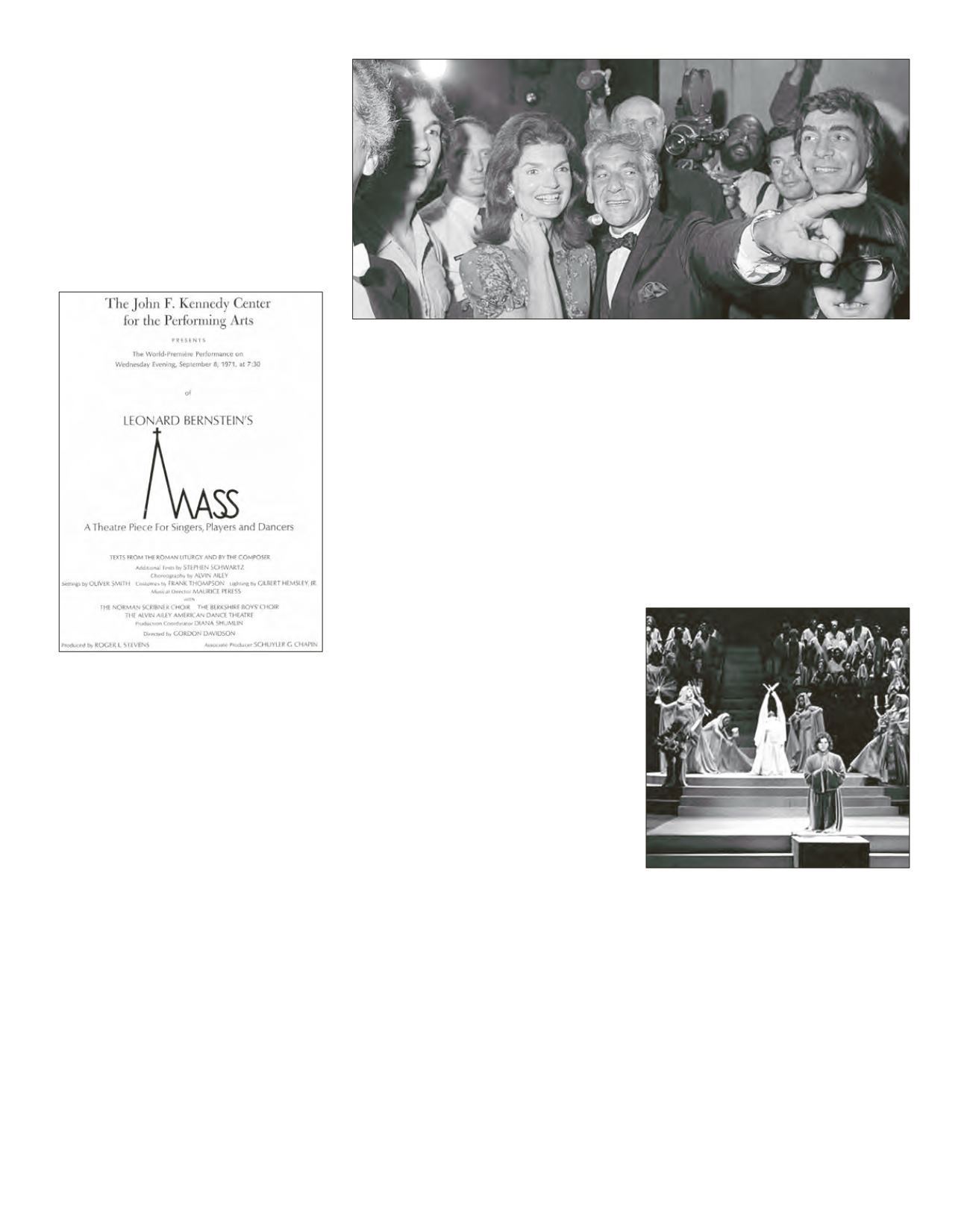

had so successfully partnered with Bernstein
on
West Side Story
, turned down the oppor-
tunity.) Drawing on her connections as a the-
atrical agent, Shirley suggested a 23-year-old
composer-lyricist currently enjoying his first
off-Broadway success with
Godspell
, a musical
theater adaptation of the Gospel according to
Saint Matthew—Stephen Schwartz. Shirley took
her reluctant brother to the
Godspell
produc-
tion, and Lenny subsequently talked through
his
Mass
concept with Schwartz. “Oh my God,
this is it,” Lenny reported to Shirley. “Now I can
finish
Mass
.”
After two weeks of blazing work together, Ber-
nstein and Schwartz had essentially completed
Mass
. The seasoned composer outlined the var-
ied themes in
Mass
—a memorial for President
Kennedy, a reflection of the unrest within so-
ciety and organized religion, loss of individual
faith, and hope for collective peace—and the
younger librettist translated those intentions
into contemporary language and a clear dra-
matic organization. “What happened was the
entire work, from a lyric point of view, is first
draft,” Schwartz recalled. “As soon as a piece was
completed to some sort of satisfactory end, we
moved on. And there really was not the time to
go back and improve the work.” Decades later, a
more mature wordsmith no longer working un-
der the extreme press of time, Schwartz revised
his
Mass
lyrics without changing a note of Bern-
stein’s music. The Bernstein Estate accepted the
majority of these new lyrics, which premiered in
an August 19, 2004, performance at the Holly-
wood Bowl.
The final month before the premiere brought an
avalanche of activity. In early August, Bernstein
oversaw production of the quadraphonic re-
cordings, heard throughout the score, in CBS’s
high-tech recording studios in New York City.
Hershy Kay and Jonathan Tunick were selected
to provide orchestrations. Tom Cothran—the
former music director at KKHI, a now-defunct
AM classical music radio station in San Fran-
cisco, and Bernstein’s new personal assistant—
thoroughly proofread the score and oversaw the
frantic last-minute copying of parts in a Wash-
ington, DC, hotel room.
As the subtitle explains,
Mass
is not a liturgical
work but “a theater piece for singers, players, and
dancers,” a musical theater composition based
on a ritual model. Bernstein produced his most
musically ecumenical score, a kaleidoscope of
classical, jazz, rock, musical theater, folk, and
gospel styles, in a work that confronted grandi-
ose, almost universal human conditions, much
as his admired Gustav Mahler had done decades
before. “I feel it’s a work I have been writing
my entire life,” Bernstein once confessed. The
original production of
Mass
required a large
production team: Gordon Davidson (director),
Alvin Ailey (choreographer), Oliver Smith (set
design), Frank Thompson (costumes), Gilbert
Hemsley Jr. (lighting), Maurice Peress (conduc-
tor), Roger L. Stevens (producer), and Schuler
G. Chapin (associate producer). The cast in-
cluded Alan Titus (the Celebrant), the Norman
Scribner Choir, Berkshire Boys’ Choir, Alvin
Ailey American Dance Theatre, and instrumen-
talists. The premiere took place on September 8,
1971, with members of the Kennedy family in
attendance. President Kennedy’s widow, Jac-
queline, who by that time had married Aristotle
Onassis, was conspicuously absent.
Bernstein’s decision to compose a work entitled
Mass
, the most central musical statement in
Christian observance, provoked much contro-
versy. Even Peress, a former assistant conductor
for Bernstein at the New York Philharmonic,
questioned, “What’s a Jewish boy like you doing
writing a mass?” This monumental score was
Bernstein’s musical exercise in questioning au-
thority, examining personal integrity, and—as
in the case of his Symphony No.
3 (
Kaddish
),
written eight years earlier—struggling bitterly
with matters of faith. The Celebrant, whom Per-
ess described as suffering a midlife crisis, bears
more than a passing resemblance to the 53-year-
old composer-conductor-pianist. The choice of
Christian subject matter stirred enough hullaba-
loo, but Bernstein ignited a veritable firestorm
with his approach to dramatizing the venerable
Latin text. The Celebrant’s crisis of faith during
Fraction
: “Things Get Broken,” when he hurls
the sacrament to the floor, produced the loudest
cries of sacrilege. As in
Kaddish
, faith is affirmed
at the end after a tortured spiritual voyage.
I.
Devotion before Mass
.
Pre-recorded voices
enter sequentially, pleading for mercy (“Kyrie
eleison”) to a highly chromatic melody. Their
cacophonous chorus builds “to a point of max-
imum confusion,” when a spotlight focuses on
a young man in blue jeans and basic shirt—the
Celebrant—who sings “A Simple Song” of praise
to his own guitar accompaniment. The pre-re-
corded voices respond by scat-singing “Alleluia.”
II.
First Introit
(Rondo).
The exultation spills
onto the stage as a marching band leads the
Street Chorus and Children’s Choir to the altar
of God. The Celebrant pronounces the liturgical
salutation, “Dominus vobiscum” (“God be with
Program cover for the premiere of Bernstein’s
Mass
Jacqueline Kennedy Onassis tours the John F. Kennedy Center for the Performing Arts with Leonard Bernstein
(1972)
Scene from the premiere of Bernstein’s
Mass
RAVINIA MAGAZINE | JULY 23 – JULY 29, 2018
122









